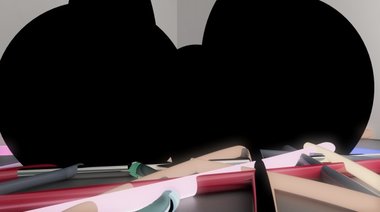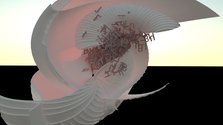John Hurrell – 18 September, 2011
You sometimes get the feeling Alwast just likes moving elements around on screen, enjoying the visceral sensations he can create within his audience, but that he lacks the tools to really disturb them. It is a problem within the medium that someone like Richard Killeen has as well. The difficulty in making images that are truly memorable.
Peter Alwast is an Australian artist highly regarded for his digital moving image projects, for which he won The Premier of Queensland New Media Award in 2008. For this show the catalogue essay is a conversation between him and Grant Stevens, another new media artist who has shown his own remarkable digital work in Auckland at Starkwhite.
At the IMA Alwast has two adjacent rooms for projecting his videos, each space an installation. The larger gallery has nine simultaneous rectangular projections while the smaller room next door has one, with two static images (one cut in reflective Perspex) on the floor and end wall.
If you as a viewer come to this exhibition expecting some sort of conceptual unity then if it exists perhaps the key to that lies in the small room. On a flatscreen on the far end wall is a coloured image of a city at night with a huge moon slowly rising up behind the tall buildings. The voiceover tells you the story of the artist’s Russian great-grandfather (b.1900) who living in Russia during the late 1930s when Stalin was in power, was foolish enough to make a joke to his workmates in a small oil company about Stalin’s ‘child bride’. The secret police came and whisked him away - never to be seen again - while Alwast’s great-grandmother and the children were removed from the family home and dumped at the railway station. (Aspects of the story have similarities with that of Nikita Mikhalkov’s astounding film Burnt By the Sun.)
On the floor in front of the screen is a large rumpled sheet on which is printed an image of the sea (a symbol for history perhaps) and on the opposite wall we see a Perspex cloud reflecting the film (the Russian nation maybe infused with the trauma of Stalin?).
Thematically the first larger room with its nine loops is much more complicated. On one wall is an animated image of a cross-section of a pale pink, paper spiralling shell morphing into different variations of its shape - and torrents of tiny letters pouring out of its centre. At the other end are a man and a woman walking towards each other on a long screen, moving but never meeting or talking. They might represent the artist thinking about meeting his great-grandmother when she was a young woman.
On the other - on the left - is a double screen, one stacked on top of the other. In the upper one are words written in cursive script that look inflatable like slender balloons, floating downwards into a grey sea and saying things like ‘thinking’, ‘working’, ‘shitting’, ‘eating’, ‘I am yours’, and ‘you are mine’. The lower one has a spinning black, blobby, cloud shape, hovering above paper strips streaked with paint and strewn across the floor, accompanied by showers of confetti-like Pae White discs fluttering downward.
Extending to the right along that wall are four other videos: a constantly rattling child’s mechanical tin top, leaning in a corner of a darkened room; sets of coloured coffins falling through a room’s ceiling; three sequences of open paper cubes, houses with their sides painted with daubed on windows or displaying portraits of a woman and Stalin, tumbling, wobbling and rolling as the cubes fall to the floor; more inflatable letters, rising up to the ceiling, flipped in reverse or in sections, sometimes including ‘you’.
Here are some of those loops for you to look at. As you’d expect, inevitably the gallery presentation exudes fragmentation, not just because of the spatially spread out nature of the videos and the highly inventive speculative level needed to construct a coherent ‘purpose’ or ‘meaning’, but also because of the formal mood of the digital technology of animation. It has a fairytale ambience, a nursery-room sweetness that doesn’t successfully sit with the brutality of the Stalin-era story. The pastel lolly colours and clean surfaces exude a chirpy optimism and innocence belied by the savage events in Alwast’s family history.
Although it is clear Alwast is interested in the post-structuralist construction of the subject as a conduit through which language flows, you also get the feeling he just likes moving elements around on screen, enjoying the visceral sensations he can create within his audience, but that he lacks (and perhaps wants) the tools to really disturb them. It is a problem within the medium (it seems perpetually sanitised and bland) that someone like Richard Killeen has as well. The difficulty in making images that are truly memorable.
John Hurrell
Recent Comments
Peter Alwast
Thanks John, Perhaps you are right that the 'sinister' imagery of the written word in the single channel work didn't ...
John Hurrell
Readers interested in this discussion can find the essay for the show at http://www.peteralwast.com/Read%20Peter%20Alwast.html, plus all the ten videos from ...
Peter Alwast
John, Thanks for fixing up the factual errors which you made in your initial review. But I do think there ...



 Advertising in this column
Advertising in this column Two Rooms presents a program of residencies and projects
Two Rooms presents a program of residencies and projects



This Discussion has 3 comments.
Comment
Peter Alwast, 9:05 p.m. 25 November, 2011 #
John,
Thanks for fixing up the factual errors which you made in your initial review. But I do think there are some fundamental qualities (which were picked up on by both other people, artists and non-traditional art going public) that you do not mention.
You make no mention of the title of the show 'Future Perfect', or Repetition, which features in every single channel of the exhibition, both in formal and metaphoric ways.
The way repetition relates to time or the desire to suspend it?
The way the motif of light hitting the corner of the room features in 9 of the channels, and how this may relate to the passing of time?
The way repetition fundamentally has 'no purpose' other than to repeat, or defer 'arrival' and to maintain the status quo, or even hold at bay the unconscious?
And how all these concepts may relate to the use of both the 'virtual' (animation) and 'real' (video)in the different channels?
You do pick up on the issue of contradiction and I agree it is consistent throughout the exhibition.
There is a formal language to the show which is then betrayed by the 'obtuse', speculative or poetic range of imagery, and in many ways that is the point of the exhibition. The relationship between the desire to repeat in order to maintain consistency and the fear of rupture in its various guises, including fragmentary speculation.
John Hurrell, 9:52 p.m. 25 November, 2011 #
Readers interested in this discussion can find the essay for the show at http://www.peteralwast.com/Read%20Peter%20Alwast.html, plus all the ten videos from the two rooms. My view is that the visual imagery of the animated video loops didn't successfully lock in with the mental imagery generated by the written word in the smaller darkened room, that being more evocative and sinister.
I'm curious as to why you, Peter, would think that repetition (in the form of loops), and light illuminating room corners, are linked to the unconscious mind as tropes. (On what basis? It's terribly vague. Is it for example from Lacan, correlating the unconscious with the syntax of a language?). I can see repetition as a form of stasis might be connected, for sure - but that would mean the repetition isn't noticed I think.
It is obvious artists can't control how their work is interpreted - be that formal or semantic aspects. And the show's title could (as a false trail) be about verb tenses, not about the perfect 'futures' after the Stalinist era that I think you have in mind.
Peter Alwast, 11:01 p.m. 27 November, 2011 #
Thanks John,
Perhaps you are right that the 'sinister' imagery of the written word in the single channel work didn't lock in with the 9 channels of the first room. But it is the very last thing that is seen after walking through the entire exhibition, the last channel is hidden at the end of a different room to the first channels. So there is a particular kind of relationship that is set up between the two.
In your response to my comment you combine light illuminating the corner of the rooms and the unconscious when in fact I mentioned them in different contexts -
1. Light illuminating a space relates to time (I can't make this any clearer except that light changes as the Earth spins, however in the exhibition the light stays the same, or does not transition fully).
2. Repetition relating to repression of the unconscious, among other things. But they are not independent and there is a link between the two. The return of the same is also a deferral of time, nothing changes - the way we repress the reality of our own death and the passage of time. We do say and see the same thing over and over again in a loop. These things were in the show.
To address the theoretical component you mention - it is not only me only who thinks there is relationship between the unconscious and repetition but many other people - thinkers, artists etc. This concept is not vague at all and anyone interested in any aspect of the unconscious from a psychoanalytic context could know or find out that Freud devoted a whole book to it in 'Beyond The Pleasure Principle, as does Lacan in a number of seminars.
I do agree with you that in life repetition isn't noticed, and becomes a way of trying to deal with something unresolved or maintaining the status quo. But this is art and not life and I have used the structure of repetition or the loop in each of the channels to keep things the same - things/objects in the videos spin around endlessly or leave and return to vision keeping it all the same. Because as I said the show is about the relationship of repetition and rupture. I also built into the channels various disruptive qualities that have a beginning and end structure such as objects falling (coffins) or being thrown (cubes), or the spinning top and my great-grandfather's murder.
I agree artists can't control interpretations; I am just responding to the lack of one.
Finally the show's title CAN be read as just a possible 'Perfect Future' - place of perfection in the future. This response is fine and relates to many qualities of the exhibition. But if someone is interested in a closer reading 'Future Perfect' is a verb tense that leads us down the trail (not false!) of an event in the future which I look back on as if it has already occurred. For example; "Tomorrow, John will have read my recent post and agreed with everything!"
How this relates to the show, if any reader has even gotten this far, is up to you to work out.
Participate
Register to Participate.
Sign in
Sign in to an existing account.